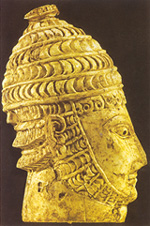 |
The Greek Age of Bronze
Middle Helmets |
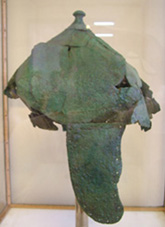 |
 Achaean and Aegean helmets 1500-1300 BC Based on pottery, fresco, sculpture representations and partial findings. Achaean and Aegean helmets 1500-1300 BC Based on pottery, fresco, sculpture representations and partial findings. |
Two interesting helmets are represented in a seal-stone from Thisbe Boeotia dated LH II (about 1500 BC). The warrior on the left seems to wear a conical reinforced or decorated helmet with nose guard and hourse tail. The other warrior is probably wearing a padded helmet also in this case decorated with metal disks and in the upper part with boar tusks.
Even if the autenticity of the seal-stones from the Thisbe "treasure of seals" is actually questionable their iconographic model are significative being more likely based on real speciments. |
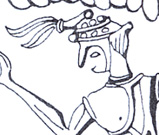 |
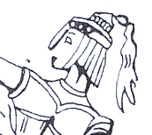 |
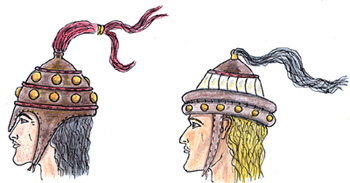 |
Even if the above seal-stone representations are very schematic a possible reconstruction of the two helmets can be reasonably hypothize. |
| A very clear image of a conical helmet probably made with concentic bands of leather or other perishable material is depicted in this vase from Isopata near Knossos dated around 1500 BC. The helmet has cheek and neck guards but without crest or hourse tail.
|
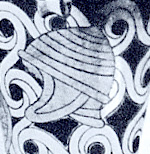 |
| Same kind of conical concentric band helmet is also well represented in this other vase from Knossos dated around 1500 BC.
|
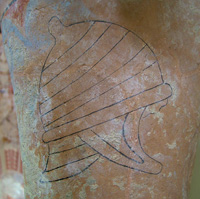 |
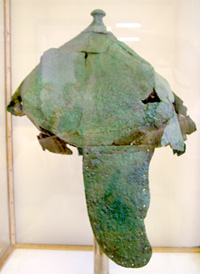 |
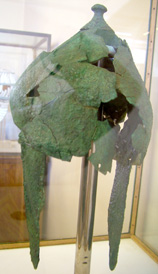 |
Similar conical helmet made of bronze has been found in one of the as called "warriors' graves" near Knossos dated around 1450 BC. This specimen has two large cheek guards probably stitched or riveted to the helmet and an upper pierced knot to hold a crest.
Small holes all around the cheek guards and helmet lower edge were used for attachment of an internal padding more likely made of linen, felt or leather. |
| Together the helmet a round embossed metal disc of 5 cm in diameter has been also found. This disk was made of lead covered with bronze. The archaeologists suggest that the disc could have been a reinforcement plate placed on a perishable material neck guard attached to the back lower edge of the helmet.
|
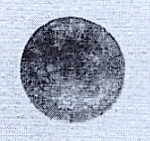 |
 |
| A bronze helmet dated about 16th century BC, have been also found in one room of the Achaean palace in the site of Aghios Vassilios hill near the village of Xirokambi in Laconia.
|
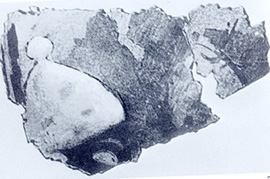 |
A conical helmet which shows similarity in the general shape with the one found in Crete but without cheek guards, is also depicted on a fresco fragment from Mycenae dated around 1400 BC. Also in this case the helmet was probaly made of bronze with an upper bigger knot but without the crest. |
| A strange helmet probably made of concentric bands is depicted in this pottery fragment from Knossos dated around 1380 BC. This helmets has an unusual and difficult to identify crest holder and it is equipped with a long decorated tail probably made of fabric.
|
 |
 |
Another strange helmet is represented in this Hittite fragment of clay vessel from Bogazkoy dated around 1350 BC. In this images a warrior, who because of his general outfit has been interpreted by the scholars as one of the Ahhiyawa (Achaeans) warlord mentioned on several Hittite tablets (see also the page dedicated to the Trojan war) is equipped with a elaborate helmet probably made of interlaced leather strips, cheek and neck guards, one frontal horn, an upper tube with small crest in the lower area, and crest holder with long horse tail. |
| The recostructive hypothesis of this helmet has been well represented in this drawing by Giorgio Albertini. The Interlaced design devided in sections was probably similar to the leather internal structure of the boar-tusks helmets. Based on some Minoan/Achaean helmets the frontal horn was also more likely made with a boar tusk.
|
 |
| An elaborate helmet with horns, upper tube and long neck guards seems also worn by the warrior with bowl represented in this Achaean-Cypriote seal from Cyprus dated XV-XIV century BC. The chariot driver seems equipped with a simple conical helmet probably with cheek guards.
|
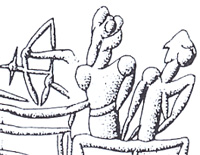 |
| An helmet decorated with glass parts was reported from the Tholos of Dendra, from the so-called burial of the "King", in pit I dated LH IIIA1 (about 1420-1380 BC). Several glass items were found around the head of the warrior. They are eleven curls of turquoise blue glass with a lot of pitting, nine narrow, slightly curved triangles of similar glass, eight heavily corroded turquoise or dark blue rectangular plaques decorated with the scene of possibly a woman riding sideways on an animal, and three more dark blue rectangular plaques showing a multi-figure scene. In all glass elements there are holes for fastening them onto a perishable material backgrund. In Persson's opinon these glass parts were sewn onto a leather helmet: the curls like curls of hair along the edge of the helmet and the triangular and rectangular plaques alternating in band.
|
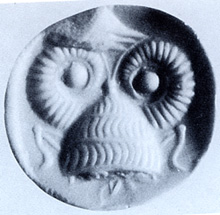 |
A beautiful boar tusks helmet with two large circular crests and central plume is represented on a seal from Vafiò dated around LH II (about 1500 BC). It is not clear if the two circular embossed parts represent a decorative elements hanging from the helmet's crests or are only seal motif not related with the helmet parts. It is also difficult to identify the two elements under the crests which more likely could represent small decorative tubes with plumes. |
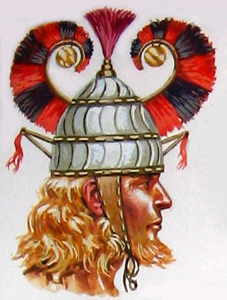 |
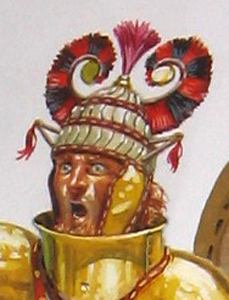 |
It is not even clear if the two large circular crests represented on the helmet from Vafiò seal have to be intended as placed in front and back or right and left of the helmet's dome, so both the hypothesis are reasonable. |
| About from the same period is this boar tusk helmet with large circular crest represented in a seal from the chamber tomb n. 518 in Mycenae. |
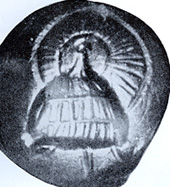 |
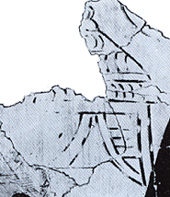 |
A boar tusk helmet with cheek and neck guards is represented on a small altar dated around 1500 BC from the palace of Mycenae. |
Boar tusks used as helmet reinforcements have been found in several graves and settlments in Greek mainland and Crete. At least twenty to forty boars were necessary to made an elaborate helmet.
About 50 glass imitation of boar's tusk plates from a boar's tusk helmet were found in a rich chamber tomb at Spata in Attica. In the same tomb real boar's tusks were also found. The glass tusks are wider then the real ones, but they have the same slight bend and the same alternating curvature. Each plaque has two perfrations. No closer date is available for these elements. This glass helmet was not just a precious and prestigious item of shining, dark blue color, but could be used as a real helmet as well since protection for the head does not derive from the plaques alone-either real or imitated- but rather from leather helmet on which they were sewn. |
| Well preserved boar tusks used for helmet dated 14th century BC from the site of Aghios Vassilios hill near the village of Xirokambi in Laconia. |
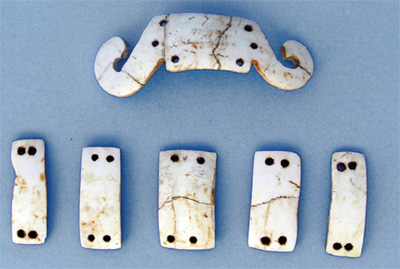 |
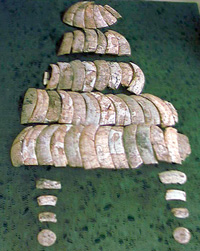 |
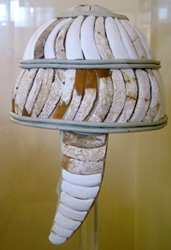 |
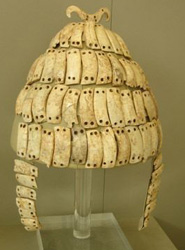 |
Reconstructions of boar tusks helmets based on elements found respectively in Pylos, Knossos, and Mycenae. |
In this drawing by Peter Connolly the general structure of a typical boar tusks helmet is well represented. The helmet was made of felt and several layers of leather strips. The boar tusks were sewed on external leather strips placed in longitudinal rows.
The boar tusks helmets have been utilized during all the Greek Bronze Age periods (see also the pages dedicated to the early and late period helmets) and are also attested in the Iliad (*1) |
 |
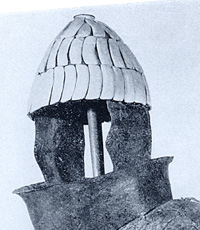 |
About 50 Boar tusks and two bronze cheek guards have been found in the tomb n. 18 of Dendra together the complete suit of armour (see the pages dedicated to the armour and the greaves) dated between LH II and LH IIB (1450-1400). This finding attested as composite helmets made of different materials or elements were also used. |
| The two cheek pieces have a form similar to the ones of the bronze helmet found in Knossos, even if the ones from Knossos are narrower and longish in comparison with the Dendra's specimens. Also in this case the cheek guards have holes along the edges for fastening the lining. Traced of thongs are preserved in some of the holes. |
 |
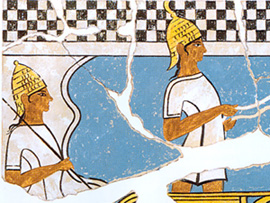 |
Boar tusks helmet are worn by the two warriors depicted in this fresco from Pylos dated around LH IIIA/B (about 1350 BC). The helmets have five to six rows of boar tusks and long neck guard, but no cheek guards. The hemet of the charioteer is equipped with a small crest in shape of crescent moon. |
| The same types of boar tusks helmets are depicted in this other fresco from Pylos date in the same period. This hand-to-hand combat scene is probably to be intended between the palace warriors and some local savages or barbarians population wearing animal skin knotted over the shoulder.
|
| Similar scene of the same period is always from another fresco from Pylos. Also in this case palace warriors with short daggers and boar tusks helmets are fighting against local savages population. |
| 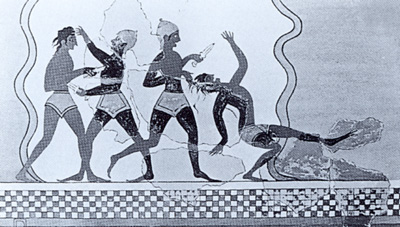 |
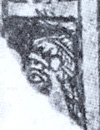 |
An elaborate boar tusk helmet with plumes is represented in this fresco fragment fron Thebes dated around LH IIIA. |
|
| Several are the Pylos's fresco fragments with battle scenes or warriors representations. mostly of these warriors are wearing the typical Achaean conical helmet reinforced with boar tusks. |
|  |
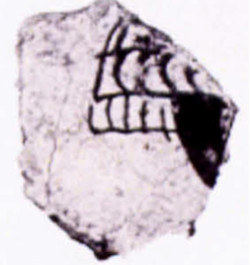 |
Other conical boar tusked helmet probably with leather or bronze cheek piece dated LH II-LH-IIIB from Pylos. |
|
| In another fresco from Mycenae probably dated LH IIIA/B (about 1350 BC) a warrior seems to wear a boar tusk helmet with long cheek and neck guards and upper knot. Because the very bad preservation of the original fresco it is difficult to identity the exact helmet features. Like similar helmets attested in other representations, also this one could be interpreted as a composite helmet made of leather, boar tusks and bronze elements.
|
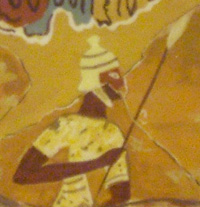 |
| A possible reconstruction of such composite helmet made of a substrate of leather reinforced with boar tusks and bronze elements can be reasonably hypotize. Even if because of the poor preservation of the original painting this helmet could also has been completelly covered with boar tusks as wel as completelly made of bronze. |
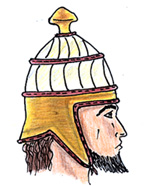 |
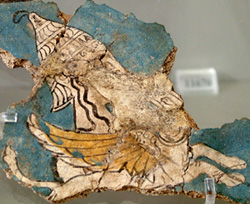 |
Another interesting boar tusk helmet is well represented in this fresco fragment from Mycenae dated around LH IIIA/B (about 1350 BC). This helmet seems to be without cheek guards but it is equipped with a long neck protection also reinforced with boar tusks. |
|
Very interesting conical bronze helmet 18.1 cm. high from Aegean or Balkan area dated around 14th-13th century BC.
The bell-shaped helmet and knob finial formed from a single sheet of hammered bronze, the knob finial with a central perforation, reinforced on the interior with a small bronze sheet joined by three rivets, the bottom edge with perforations along the perimeter, ornamented with three incised registers below the finial and two incised registers above the bottom edge, each register composed of hatched curving lines running in opposite directions, the registers separated by hatched lines, the bottom register interrupted by four intertwined spirals. The pattern of the incised wavy lines within distinct registers clearly imitates the arrangement of the boar tusks on Achaean helmets. The spiral motif along the lower register is also common within the Achaean artistic repertoire.
|
 |
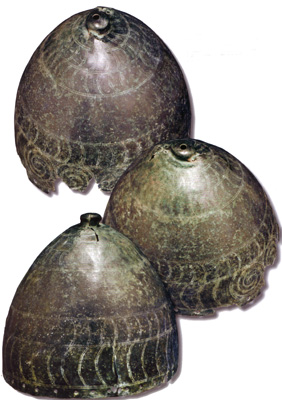 |
| Drawing (below) of the paragnathids from Tomb 12 of the Dendra necropolis, the so-called "tomb of the armor", in relation (above) to the bronze Mycenaean helmet in the Ashmolean Museum.
|
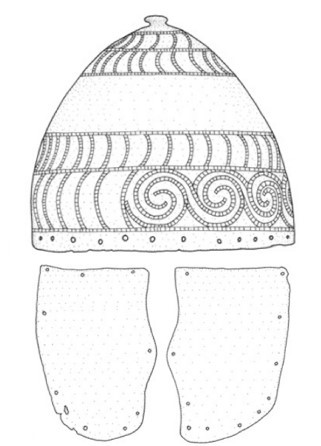 |
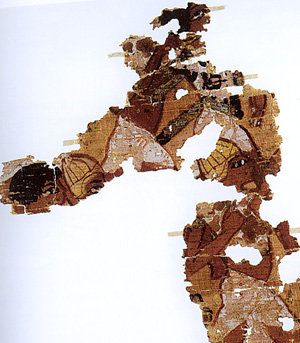 |
Outside the Greek mainland and Aegean Island a possible representation of Achaean warriors equipped with boar tusks helmets is from an Egyptian papyrus fragments from Tell el-Amarna, home of Amenhotep III's son, dated around 1350 BC (*2). In this papyrus some warriors are depicted with conical pale-yellow helmets which remaind in general design the typical Aegean boar tusks helmet.
This identification is strengthened by the find of a piece of boar’s tusk, with perforations for attaching it to a leather frame, during excavations at Qantir, the site of the Ramesside capital Pi-ramesse in the eastern delta. It appears likely that this piece was part of the famous boar’stusk helmets worn by the Achaean elite. These elements and the recent discovery in Kanakia, Salaminas island of a corselet bronze scale with the stamp of pharaoh Ramesses II (see the page dedicated to the scale armour) are clear evidences that Achaean mercenaries have been on duty in the Egyptian troops in different periods. |
 |
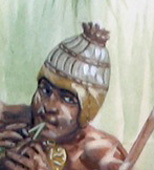 |
From outside the Aegean area is also this fragment of Achaean ivory sculpture representing a typical boar tusks helmet dated around LH IIIA/B (about 1350 BC). This specimen has been found in Mitza Purdia near Decimoputzu in Sardinia Island.
In Sardinia island several Achaean/Aegean or Sea people style related manufactures like pottery, ox-hide, weaponry, sulpture, and later bronze statuettes of warriors representation are attested (see also the page dedicated to the Sea People) |
| 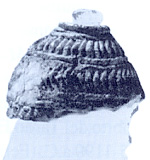 |
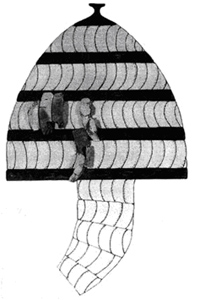 |
Several interesting boar tusks part of warrior helmet are also attested in Serbia (Yugoslavia) These elements have been found in grave dated around XIV XIII Century BC |
|
| An ivory warrior's head with boar tusk helmet representation dated around 1300 BC if from Enkomi Cyprus unfortunately the bad status of the remain do not allow a clear identification of the details. |
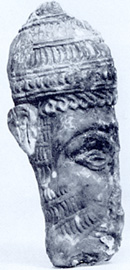 |
 |
Typical ivory sculpure of warrior's head with elaborate boar tusks helmet has been found in Myceanae dated around LH IIIA/B (about 1300 BC). The helmet is equipped with cheek guards also reinforced with boar tusks and a neck guard probably made with the letaher strips which are also part of the internal helmet.
|
| From Mycenae is also this relief dated around 1300 BC of a warrior's head with a similar boar tusks helmet equipped with cheek guards reinforced with boar tusks and leather strips neck guard. |
| 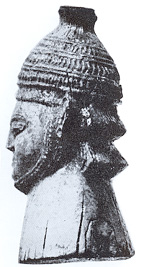 |
 |
In this ivory plate from Delos dated LH IIIA/B (about 1350 BC) a warrior is equipped with simple conical boar tusks helmet without cheek and neck guards but with a large knot and horse tail. |
|
| A beautifull ivory representation of an elaborate boar tusks helmet with cheeks and neck guards dated around XIV century BC has been found in the side-chamber of Tholos Tomb A in Arkhanes. This helmet is very similar in design to the ones attested in Mycenae. |
| 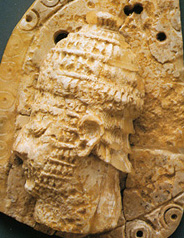 |
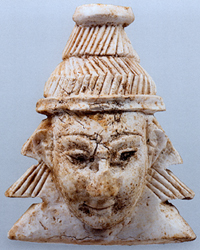 |
Another beautifull ivory representation of boar tusks helmet with large neck guards from Khania Crete dated around LM IIIA-B (about 1350-1250 BC) . |
|
| CONCLUSION
|
| Different types of Aegean helmet are attested in a period between the 1500 and 1300 BC. The padded leather helmets made of concentric strips of leather sometimes reinforced with metal elements typical of the Late Helladic early periods are still used as well as the ones reinforced with boar tusks. In particular this typical Achaean helmet reached its maximum usage during this period being attest in mostly of the art representations (fresco, sculpture, painting, seal etc...) as well as partial findings in all the Aegean areas and in other Mediterranean places.
This helmet shows different design and several variants in general shape, crests, horse tails, cheek and neck guards. Evidences of composite helmets made of leather reinforced both with boar tusks and bronze elements have also been found in the famous Dendra tomb. Even if the majority of the helmets used in this period were made of perishable material reinforced with other elements, helmets completely made of bronze were also used as attested by the specimen found in Crete.
|
(*2)The British Museum has acquired some 40 fragments of a painted papyrus from Amarna (inv. no. EA 74100) with a unique representation of a battle. It was found in 1936 in a building which was probably a chapel dedicated to the cult of a king. The battle scene is preserved in two main areas. The first scene shows a group of Libyan archers attacking an Egyptian, while the second shows a group of running warriors, arranged in two overlapping registers. There is a very fragmentary third scene with similar figures. All the soldiers wear white kilts typical of Egyptian troops. Some wear helmet similar to Egyptian representation of gurpisu helmets worn by Asiatics. These helmets may actually have represented Achaean boar's tusk helmets. Some of the soldiers wear oxhide tunics which may have been lined with metal strips. This too is compatible with Achaean depictions of warriors.
|
|